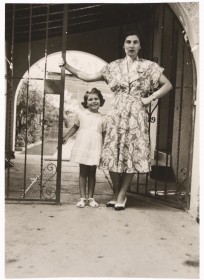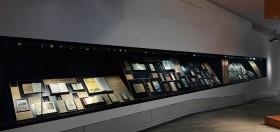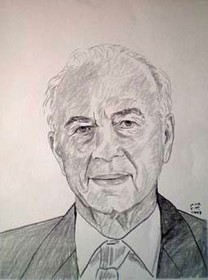A Look at the Radzewski Family Photo Collection
We all have family: father, mother, children, grandchildren, grandparents, aunts, uncles, or just relatives casually come across at family reunions or known from photos. “The uncle, living abroad, with the daughter and the grandchildren – don’t you remember him?” We’ve all heard that.

The donor, Vera de Jong with her mother, Meta Krotoschiner in front of their home in Santiago, Chile, in 1952, following immigration © Jewish Museum Berlin, gift of Vera de Jong, née Krotoschiner-Radzewski
What happens when there’s no one to keep telling these stories? Only a photo of these people remain, if you’re lucky, sometimes a postcard that says nothing. This isn’t only the case in our private lives. As museum workers, we confront this challenge on a daily basis, especially when inventorying collections of donors’ family photographs. Each photo poses the same questions: Where was this? Who were these people – friends or relatives? What’s the story behind the image?
Fortunately we have help. Along with the photographs, donors provide and entrust us with their memories. Vera de Jong, born Krotoschiner-Radzewski, is one such example. Last year she gave our museum some 200 family photos (further information about the Photographic Collection on our website). As an academic trainee, it was then my task to inventory this collection and research its history. I was immediately taken by these charming images and, while researching them, understood their historical value, helping us uncover more than a century of family history. → continue reading

View of the cabinet exhibition “In a foreign country. Publications from the Displaced Persons Camps” in the basement of the Libeskind Building.
© Jewish Museum Berlin, photo: Jens Ziehe
In our cabinet exhibition “In a foreign country” we explore the publishing operations of survivors and refugees, the so-called displaced persons (DPs) who were stranded in occupied Germany after 1945. For this show we selected the widest variety of genres: schoolbooks, Judaica, volumes of poetry and prose, historical documentation, and Zionist pamphlets.
They all have two things in common: first, the quality of the paper these post-war printers used was extremely bad. Second, they all come from the Berlin State Library, whom we’re hosting for this exhibition due to its historically valuable collection of DP literature.
With one little exception. → continue reading
Remembering 4 November 1995
Twenty years ago today, 4 November 1995, Israel prime minister, Yitzhak Rabin, was assassinated following a peace rally in central Tel Aviv. Mirjam Wenzel was there.
“It was a mild evening at Kikar Malchei Yisrael (Kings of Israel Square, now Yitzhak Rabin Square) in the middle of Tel Aviv, where throngs of people had gathered under signs of shalom achshav (peace now) to show their support for Rabin and Shimon Peres and their push for peace. The national religious movement had grown more hostile towards the government in recent weeks, and the media had been reporting its demonstrations with posters of Rabin in a SS uniform. No one could imagine, at least not within my circles, that this movement could turn deadly. From the Tel Aviv office of the Friedrich Ebert Foundation, where I had a semester internship, the Oslo Accords were viewed as a political and economic fact. → continue reading


